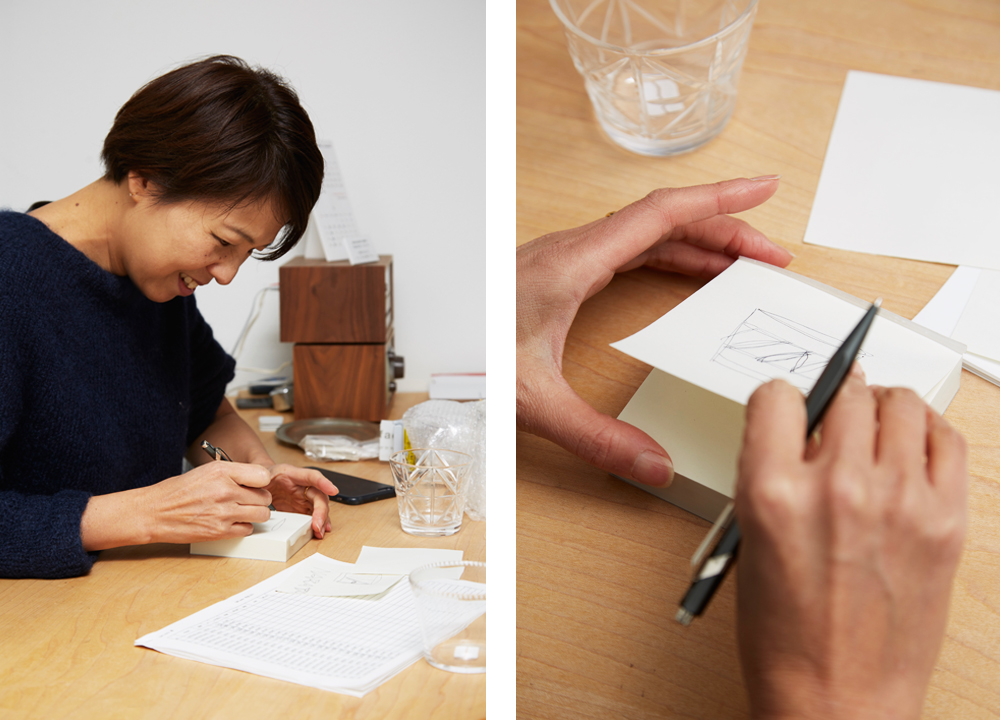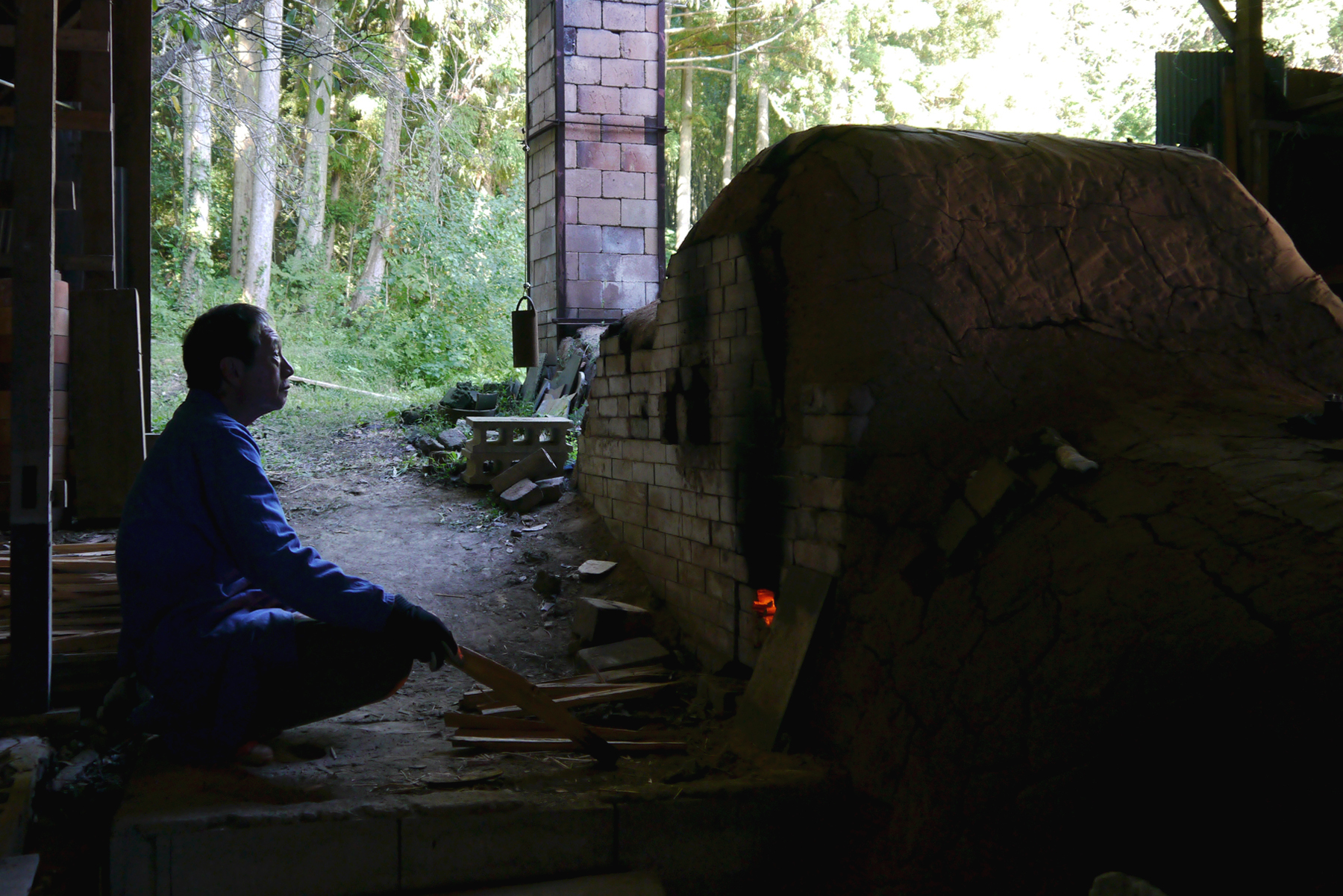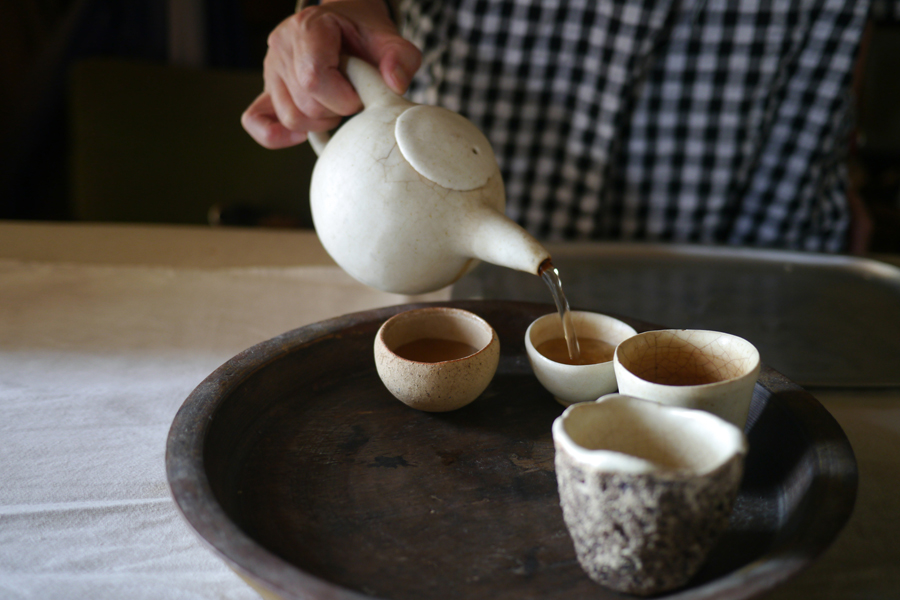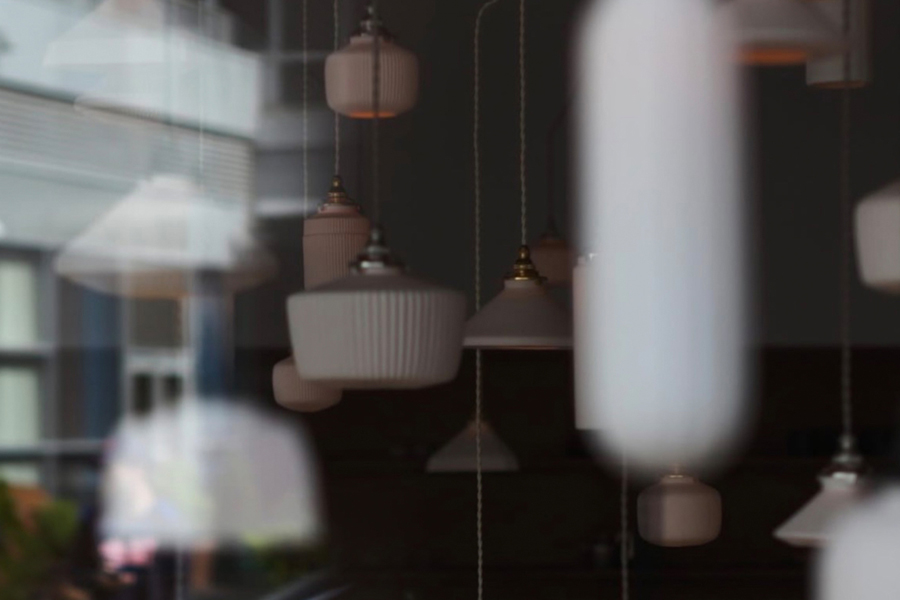Transforming States: Factory Zoomer’s Kazumi Tsuji on Finding a Calling in Glassware
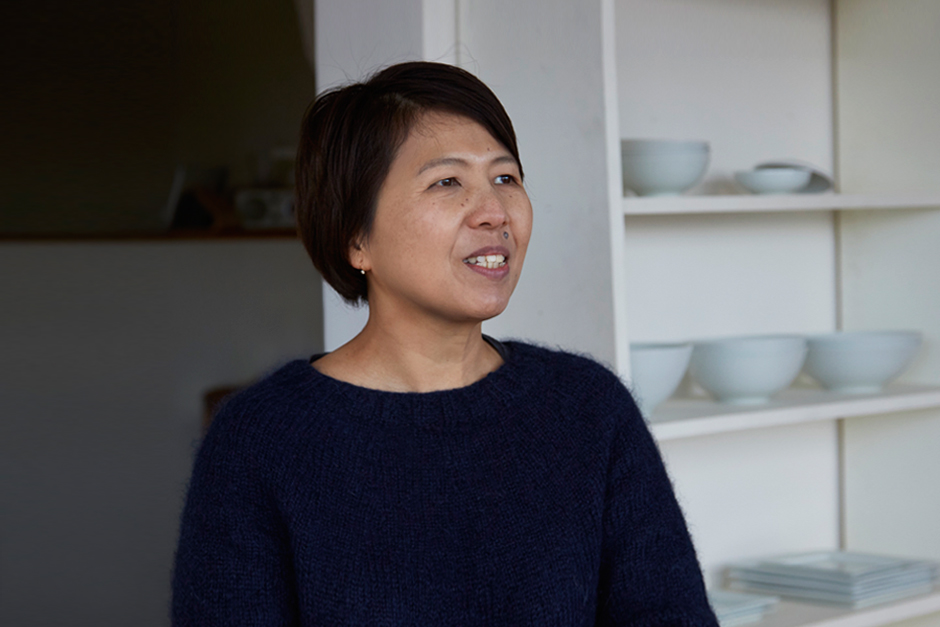
Visiting the studio of an artisan is one of my privileges as a writer, and also the most beloved aspect of my job. I’m always impressed with the way an artisan works, their well-organized processes, their techniques, and their confidant demeanor as professionals in the studio. I am unable to take my eyes off of the artisan in these moments.
In January, I visited the atelier of glass artist Kazumi Tsuji of Factory Zoomer in Kanazawa. I was especially excited to see her glassblowing demonstration right in front of me. After wrapping her hair back with a bandana, Tsuji-san started by putting a steel blowpipe into a furnace to catch molten glass on the end of the pipe. An assistant then blew into the pipe to expand the liquid mass. Tsuji-san simultaneously rolled the pipe on a bench to start forming a shape, and placed it back into the furnace to heat again – a process called bench blowing. She repeated these steps again and again.
Noteworthy was the teamwork between Tsuji-san and her staff. While her assistant was kneeling to blow in the pipe, Tsuji-san shaped the piece with large iron tweezers. With great coordination and subtle hand adjustments, they were creating functional glassware. Not only was I mesmerized by the process of transforming molten glass into something like a pitcher, I was also struck by their deliberate movements – accurate, fluid and beautiful. I thought I’d like to watch them for hours.
It’s a well-known fact that a handcrafted object is precious but through my job interviewing dozens of artisans, I’ve come to realize that the work and devotion that goes behind the craft is beyond what can be imagined. After an artisan’s studio visit, I can’t help but to appreciate their work anew. In addition, learning an artisan’s philosophy, knowing their history, and seeing their passion and energy, makes my perspective on their craft change entirely; I start to feel more connected with their work as each piece was created with love. I hope I can share this feeling with readers through my interview with Tsuji-san.
The interview was conducted in English and Japanese. Both languages are published so as to not lose any meaning in translation for native readers.
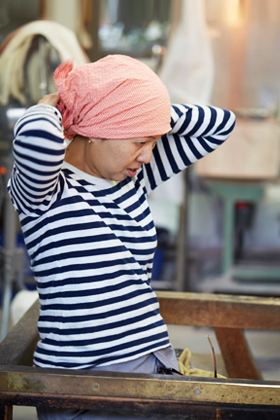
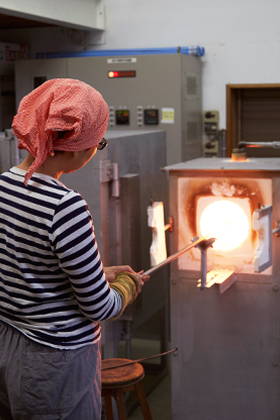
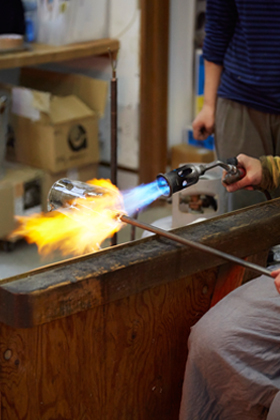
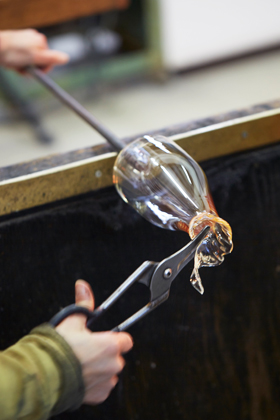
Tsuji-san, how did you get into the field of glass-making?
KT: I was planning to be a graphic designer after studying graphic design in college. Actually I longed to work at Comme des Garçons, the world-famous brand by founder Rei Kawakubo, whom I highly respected. It turned out it was impossible and I was like “well, what should I do?” While I continued to paint and create with clay and fabric I was looking for what I truly wanted to be. One day, I happened to get hold of a magazine called Stained Glass magazine, and I stumbled upon an ad for an apprenticeship at the stained glass studio of Narcissus Quagliata in San Francisco. I made up my mind to go to America supported by my dad who was like, “Go to America, and try it for yourself!” The art of stained glass created by Narcissus was something I’ve never seen before. He creates portrait paintings using pieces of blown glass. Glass is three-dimensional but his stained glass art is flat, two-dimensional. I felt a connection to his art because of my background in graphic design and painting.
辻さんがガラスの世界に入られたきっかけを教えてください。
KT: 大学の商業デザイン科でグラフィックを学び、卒業後はグラフィックデザイナーを志していたんです。敬愛する川久保玲さんのコムデギャルソンで、グラフィックの仕事ができたらな、と思ったけれど叶わず。じゃあどうしよう、絵を描きながら、土や布なんかも触ったりしながら、いろいろ模索していたんですね。そんなとき偶然手にした「ステンドグラスマガジン」という雑誌で、サンフランシスコに工房を構えるステンドグラスアーティスト、ナルシサス・クアグリアータの弟子募集の記事を見つけました。「アメリカ、行けば?」そんな父親の言葉もあって、渡米し弟子入りしました。ナルシスのステンドグラスは、今まで見たこともないようなものでね。吹きガラスのパーツで、肖像画みたいな作品を作るんですよ。彼のステンドグラスは、ガラスという立体物でありながら平面に近い。絵を描いたり、グラフィックを学んだりという私に、近い場所にあったんだと思います。
In San Francisco, were you planning to be a stained glass artist?
KT: Through learning about stained glass art at Narcissus’ studio, I became interested in making glass, a more fundamental process. I became curious about how to blow glass after seeing the beautiful gradation of color blown glass produces. So I started to learn glass blowing at the California College of the Arts (CCAC), while continuing to work as an apprentice at Narcissus’ studio. Glass blowing requires physical work using the whole body, as opposed to making stained glass where you’re stuck sitting at a table. I felt like glass blowing suited me more. Also, I liked the instantaneous actions of glass blowing. I’d say I’m a sprinter rather than a marathon runner! So that’s why I took the glass blowing path, not stained glass. Glassblowing also requires high skill and technique. Actually to this day I face difficulties again and again but when I struggle with a problem, I’m always like “I can overcome this. I have to!” These challenges are tough but enjoyable for me, even now.
そのまま、ステンドグラス作家になる、という道もあった?
KT: ステンドグラスは、吹きガラスで吹いた一枚ガラスのパーツを、さまざまに組み合わせて生み出す作品です。その工程を知って、「ガラスを作る」という根本がやりたくなった。例えば、きれいなグラデーションのガラス、どう作るんだろうって。大元の部分に、興味が湧いたんです。それで、ナルシスのスタジオで働きながら、カリフォルニア美術大学(CCAC)のガラス科に通い、吹きガラスを学びました。どうやら、ステンドグラスのパーツを机の上でちまちまと組み合わせるより、吹きガラスというもっとフィジカルな、体を使った仕事のほうが、自分に合っているようでした。短い時間に吹いて一瞬で作品を作る、そんなところも好みだった。長距離走よりも短距離走向きっていうのかな(笑)。だからステンドグラスではなく、吹きガラスの道を選びました。吹きガラスって難しいんですよ、技術的に。壁にぶつかりまくって、「克服したい!」って気持ちが湧く。そういう挑んでいく感じも楽しかった。その感覚は今も変わりません。
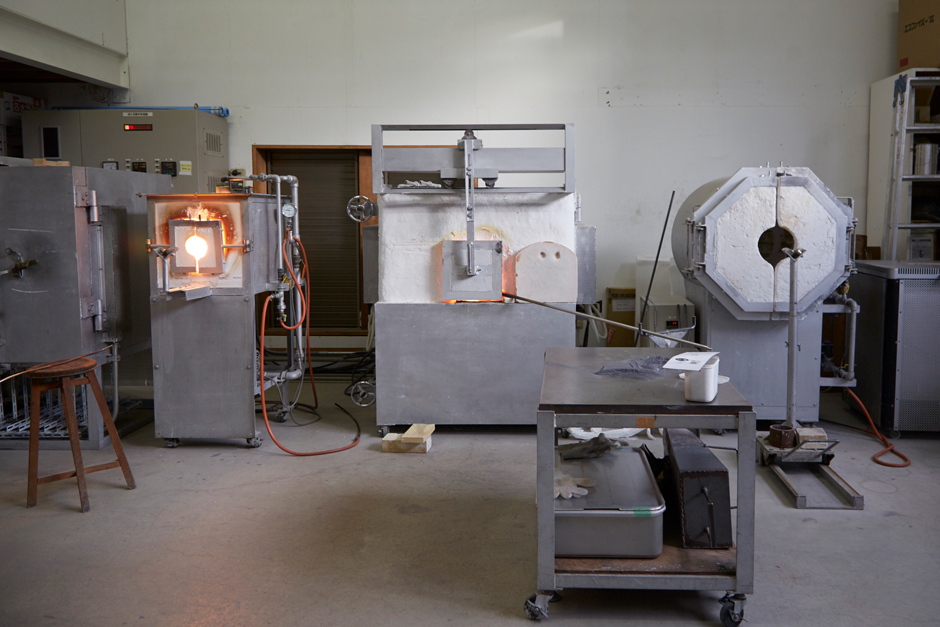
So you took the path towards glassblowing. When and how did you get started in creating tableware?
KT: After graduating from CCAC, I moved to Italy to learn glass, and then I came back to Japan. I got a job at Utatsuyama Kougei Kobo, which was founded to preserve and develop crafts in Kanazawa, and worked there as an assistant at their glass studio. I worked hard and at the end of the workday, I created personal glass blown pieces before going home to make dinner. I lived like this everyday for almost ten years. It became my ordinary day-to-day life, so it was very natural to create glass blown tableware to bring back to my apartment to use. At that time, my favorite late night snack was men [meaning noodles in Japanese], but I didn’t have a proper sized bowl for it. I also didn’t want to eat a lot of men, just a chokotto was fine for me [chokotto is used to express a ‘small amount’]. Eventually I invented a men-choko glass bowl, which is a little bit bigger than the existing soba-choko that is typically made with porcelain and used as dipping vessels for soba noodles in Japan. That was the beginning of glass tableware for me and men-choko has been selling ever since.
なるほど。そうして吹きガラスの道へ進んだ辻さんですが、食器を作り始めたのは、どういう経緯ですか?
KT: CCACを卒業し、その後イタリアで数カ月学んだ後帰国。工芸家の育成を目指す、金沢の卯辰山工芸工房で、ガラス工房の助手として10年ほど働きました。夜、仕事が終わった後、吹きガラスで自分の作品づくりをする。そういう毎日を送ってました。私はごく一般の生活者だったから、ガラスの器を作っては家に持ち帰って、食卓で使ってたんです。当時、麺ばかり食べてたんだけど、麺をちょこっとだけ食べるのに、ちょうどいいサイズの器が欲しいなと思って、そばちょこよりもひとまわり大きなサイズのガラスの器を作ったんです。それが「めんちょこ」の始まり。今ではベストセラーになりました。
You were creating glassware like men-choko and in 1999 you founded your own glass studio, called Factory Zoomer. At that time, I heard that you were also handcrafting glass works that didn’t belong to the category of tableware, right?
KT: I was engaged in the creation of two different types of glass works, tableware and art. Back to the topic of my college-life in San Francisco, I was lucky to have many opportunities to see glass art made by artists who derived from the Studio Glass Movement that occurred in the 70s in America. They declared that glassblowing is a medium in which to create art. Thereafter, handcrafted glass art using small melting furnaces became a new trend in the glass industry, where in the past, manufacturing glass at big scale factories was the norm. Glass artist, a new category of artist emerged. Accordingly, a lot of glass art galleries opened one after another. But for me, it seemed like those types of works were different from my own style. I couldn’t find my place in them. That was my experience in the 80s, but I was eager to find my own approach to glass as art in the 90s. While handcrafting glassware at Factory Zoomer, I created contemporary glass art, like transparent glass clothes for humans, large glass confining boxes, and more.
めんちょこを始めとする、ガラスの食器を制作する工房「factory zoomer」を立ち上げたのが1999年。当時は、食器以外の作品も制作していたそうですね?
KT: アートと器、二足のわらじでしたね。ちょっと話が戻るけれど、アメリカでは70年代からスタジオグラスムーブメントが興り、ちょうど私がCCACに通っていた80年代半ばは、“吹きガラスからアートを”という作品をたくさん目の当たりにできた時代です。工場で大きなガラスを生産する、が常識だったガラス業界に、個人のスタジオで、小さな炉でガラス作品を作るという新しい動きが生まれた。ガラス作家という職業も生まれた。ガラスギャラリーも次々にできました。でも、そのとき目にしたガラスアートは、自分のスタイルとは違う気がした。そこに自分の居場所を見つけることはできませんでした。そういう80年代の体験から、「自分なりのアートを作ろう!」ってなったのが、私の90年代です。factory zoomerでせっせとガラスの食器を作りつつ、ガラスの箱を作って人を閉じ込めたり、洋服みたいなガラスアートを制作したりして、ガラスを用いたコンテンポラリーアートに取り組んでました。
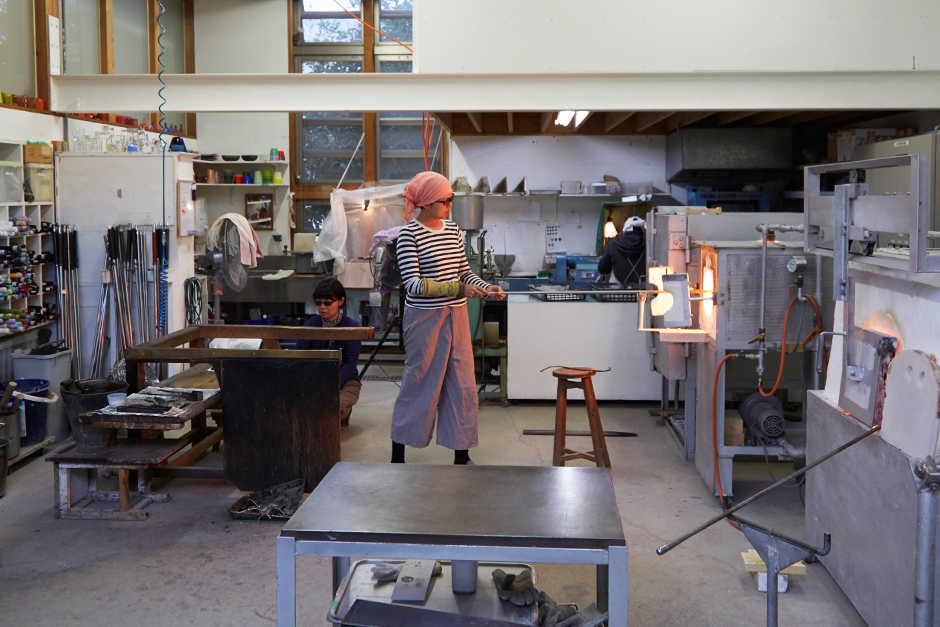
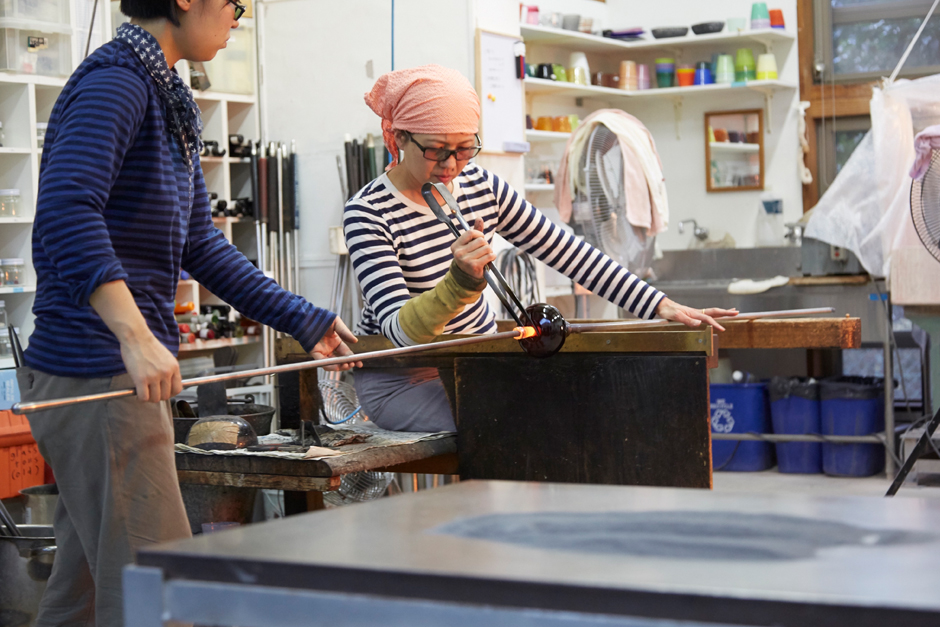
“Choosing something based on our own opinions is essential for us. If we neglect to do that, we’ll lose ourselves.” – Kazumi Tsuji
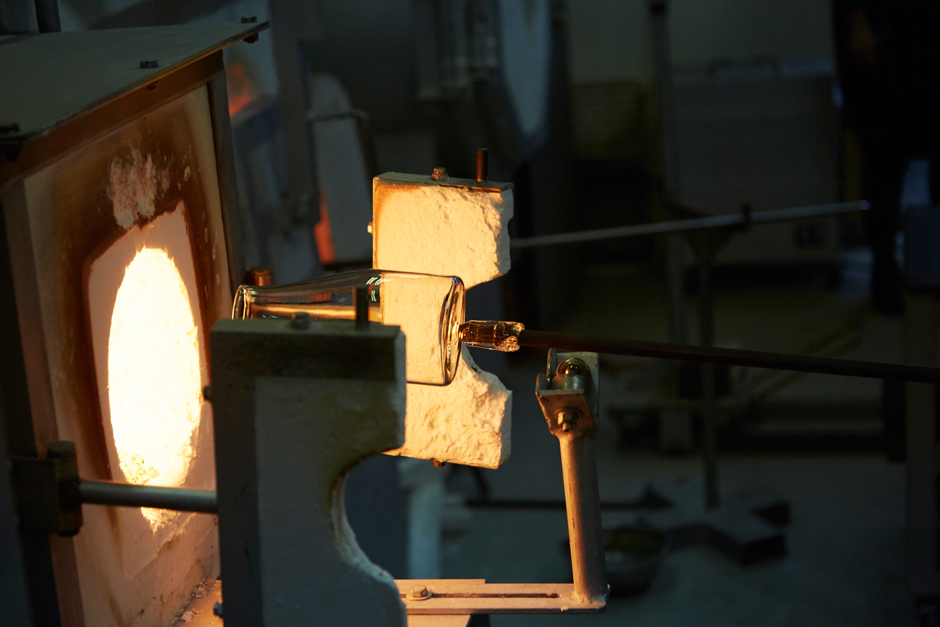
Now we’re even more curious about your contemporary glass art! Why don’t you create such pieces anymore?
KT: Art is subdominant. When I held exhibitions of my contemporary glass art, the total visitors were only around 50, many of them were contemporary art geeks! Even when I exhibited at 21st Century Museum of Contemporary Art in Kanazawa, a world-famous museum, I didn’t receive many visitors. I asked myself “Should I keep creating contemporary glass art?” Art installations depend on concepts that consider the current situation of the world, such as “Hey, human relationships have been declining recently, right?” But I think the most important thing is giving solutions to such issues. Glass art doesn’t always give palpable solutions. I realized that for me creating glass drinkware and providing them to as many customers as possible is more meaningful than showing art installations. In this manner, I can support people with their basic necessities to help them live well, like drinking water and eating meals every day. That’s called art, isn’t it? When I exhibited my glass art, most guests were like “What’s this? It’s hard to understand!” and they didn’t have a pleasant reaction. But now, many customers want to buy my glassware and they look happy holding them in their hands. That means a lot to me. I feel really satisfied. That’s why I quit creating contemporary glass art and I’ve decided that I’m going to keep handcrafting glassware.
ガラスのコンテンポラリーアート、興味深いです! でも今は、作られてないですね?
KT: アートってマイノリティなんですよ。企画展をやっても、現代美術おたくが、せいぜい50人来るか来ないかぐらい。21世紀美術館みたいな大きな美術館で展示をしても、来てくれる人は多くなかった。「これって、続けるべきなのかな?」って考えましたね。アートってね、例えば「最近、人間関係が希薄になってきたよね」っていう世の中の現状を、インスタレーションで表現して終わり。でも大事なのは「じゃあ、どうする?」っていう、その先の解決策のほうでしょう。アートにはそれがないんですよ。だったら、ガラスのコップを作って、それをできるだけたくさんの人に使ってもらうほうが、よほど有意義なんじゃないかと思ったんですよ。毎日水を飲む、ゴハンを食べる、そういう暮らしの基本の部分を、より良くする手助けができる。そのほうが、むしろアートじゃん、って。だいたい、アートを作っても「なにこれ、わかんない」って言われるし、喜ばれることもない(笑)。でも、ガラスの食器は「欲しい」って言ってもらえて、喜んでもらえるんですよ。幸せですよね。ああ、私は食器を作っていこう。そう思いました。
It seems like such thoughtful consideration is part of your personality and style. What do you think makes your glassware distinct?
KT: Hmm, Let me think… My customers often tell me that my glassware always takes on my style. The look of the glassware, like the color and design, are always changing, but the standard shape and sizes do not change as much. I don’t create delicate glassware because I often break them. I’m not a delicate woman. [Laughter]. I don’t lead the kind of life where I would need fragile glassware.
辻さんのその温かな想いというか、サービス精神みたいなものは、辻さんならではだと感じます。辻さんのガラス食器に通じる、「辻さんらしさ」って、ご自身では何だと思いますか?
KT: なんだろう。人から「何を作っても、辻さんらしくなってるね」って言われます。色とか、表面的な部分は変わるけれど、好きな形、人に使ってもらいたいものは、変わってないと思う。あと、薄くて華奢なガラスは作らない。よく壊すから。繊細な女じゃないんで、私(笑) フラジャイル(壊れやすい)なガラスを使うような生活をしてないんです。

The black enamel and the colors of your glassware like the deep navy blue reclaimed series are also impressive.
KT: Black isn’t used often for glassware in Japan but I started to make black dominant from my belief that black glassware pairs nicely with Japanese tableware. In terms of other colors, I once showcased my glass tumblers in a variation of about 50 different tints because I didn’t want to force my favorite colors on customers, I just tried to suggest colors for people so they can pick their favorites. Choosing something based on our own opinions is an essential action for us. If we neglect to do that, we’ll lose ourselves. Different colors harmonize, for example red goes well with gray. Colors also enhance each other. It’s the same with humans. We are not alone. We live together and compliment each other. Through showcasing my colorful tumblers, I hoped to convey these thoughts.
辻さんのガラス作品といえば、めんちょこの黒、reclaimedシリーズの深いブルーなど、色合いもとても印象的です。
KT: 黒は、日本のガラスにはあまり使われてこなかった色。きっと食卓に合うと思って採用しました。色といえば、50色近くのコップを作って、並べて展示販売したこともあります。自分の好きな色を人に押しつけたくないから、お客さんに自分で好きな色を選んでもらうようにしました。「自分で選ぶ」という行為は、とても大事なこと。それをしないと自分がわからなくなる。それから、色はお互いに生かされている関係でもあります。赤にグレーが合うとかね、色同士が引き立て合ったりする。それは人間も同じです。私たちは1人じゃなくて、支え合っている。例えば色とりどりのグラスの展示を通して、そんなことに気づいてもらえたらとも思いました。
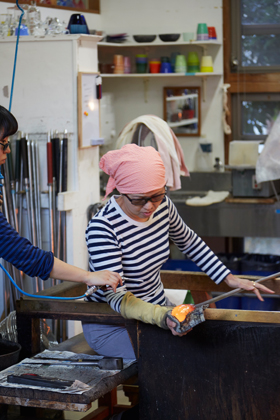
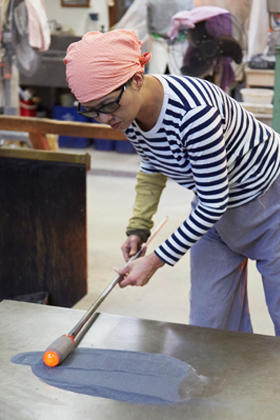
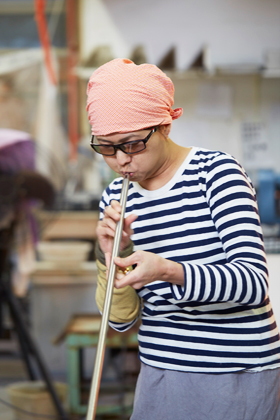
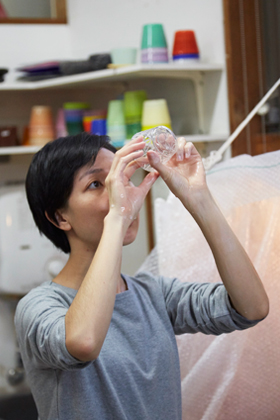
You create two lines of glassware, standard series and limited series. What’s the difference between them?
KT: Standard series is my basic glassware line that includes the original men-choko design. Limited series is a special edition collection only for exhibitions I hold several times a year. By collaborating with the owners of the galleries where my exhibitions are held, and getting inspiration from them, I create very special, one-of-a-kind glassware as part of a limited series collection.
辻さんのガラス作品は、2ラインで展開しています。スタンダードシリーズと、リミテッドシリーズ。その違いを教えてもらえますか?
KT: スタンダードシリーズは、前述のめんちょこを含む定番品。リミテッドシリーズは、年に数回の個展のために特別に制作するもので、ギャラリーの人たちの想いや空気、いろいろな刺激をもらいながら、制作しています。
You opened the Factory Zoomer shop in 2005, and a gallery in 2016, both in Kanazawa. Could you let me know your next plans?
KT: Nothing! Even the gallery project was unexpected! My only concern is my staff. I just work hard to give them a good life as glass craftsmen. As for me, there was a point when I felt like I’ve already mastered the techniques of glassblowing, but after realizing my immaturity as well as my potential of growth, I changed. Since then, I’ve been even more into creating handblown glassware.
2005年にはfactory zoomer shopを、2016年にはgalleryを金沢にオープンされました。今後の計画や予定は何かありますか?
KT: 計画は何も立ててないです! ギャラリーも降ってわいたようなものだし。スタッフたちが引き続きガラス制作という仕事で、しっかり生活できるようにしていきたい。それだけですね。私に関していえば、吹きガラスは「技術的にもう十分かな」という気持ちになったこともあるけれど、「自分、まだまだだな」と痛感することがあって。己の、のびしろを知って、最近ますますガラスがおもしろくなってきています。
